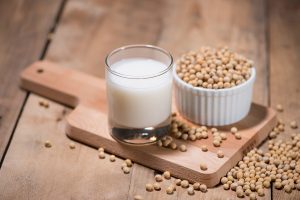 Most Manitoban dairy producers are within an hour’s drive of a processing plant, which greatly reduces milk’s carbon footprint. While Manitobans are drinking milk from outside of province too, milk is more local than other commodities. Read more about the cow to carton process here.
Most Manitoban dairy producers are within an hour’s drive of a processing plant, which greatly reduces milk’s carbon footprint. While Manitobans are drinking milk from outside of province too, milk is more local than other commodities. Read more about the cow to carton process here.
As seen in the chart below, the more processed dairy and alternatives are, the larger the carbon footprint. While the numbers are approximate, they give a good indicator of some foods to avoid or eat in lower quantity than others.
| Food | kgCO2e per pound | Car km equivalent |
| Soy Milk | 14.8 | 55 |
| Cheese | 13.5 | 50 |
| Yogurt | 2.2 | 8 |
| Milk | 1.9 | 6 |
Data source (2): Environmental Working Group (EWG)’s 2011 Meat Eater’s Guide, found here.
Case Study: Dairy Milk vs. Alternatives
In comparison to dairy milk, soy milk requires much more processing, and is mostly imported from other countries. Therefore, the lowest carbon-intensity choice may be sticking with good old cows’ milk.
For those that seek alternatives, almond milk is certainly a poor choice. Around 80% of global almonds are grown in drought-stricken California, where over four litres of water are required to produce one almond. Almond milk, like most alternatives, then requires processing (including the the adding of synthetic sugars) and further transportation.
A local alternative includes oat milk, which supports Canadian crops and can be made easily at home (find recipe here).
Case Study: Strawberry Yogurt
While from a European study (3), the following strawberry yogurt example provides excellent insight into the complexities of flavoured dairy.
To produce strawberry yogurt in Germany:
- Strawberries are imported from Poland;
- Yogurt is processed and transported from North Germany;
- Corn and wheat flour is brought in from the Netherlands;
- Jam is transported from West Germany, and sugar beet from East Germany.
Plus, there is the need for packaging to be manufactured:
- The aluminum foil cover is made 300 km away from the yogurt producer; and
- The glass jar is created at a local factory.
That’s a lot of additional inputs, all which contribute more GHGs.
Solution: Make your own yogurt or buy plain yogurt, then add your own flavours, such as Manitoba maple syrup, homemade strawberry jam, or freshly picked/home frozen fruit.




